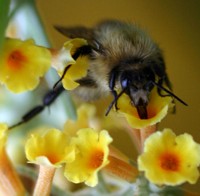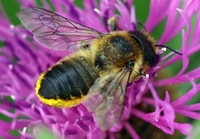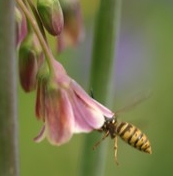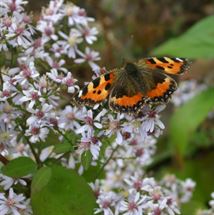
How Insects Feed from Flowers
-
The main insect groupings that include species that use flowers as a food source are:
Butterflies and Moths (Lepidoptera),
Bees and Wasps (Hymenoptera),
Flies (Diptera)
and Beetles (Coleoptera).
-
Insects may use pollen, nectar, or both of these as a food, either for adults or to feed their young.
-
Insect mouth parts vary in shape and size. This determines which types of flowers they can use.
You can download a printer-friendly PDF copy of this page here
Insects and flowers
Flowers exploit insects to achieve pollination; at the same time insects exploit flowers for food. Insects and flowers are a partnership.
Each insect group has evolved different sets of mouthparts to exploit the food that flowers provide. From the insects' point of view collecting nectar or pollen is rather like fitting a key into a lock; the mouthparts of each species can only exploit flowers of a certain size and shape.
This is why, to support insect diversity in our gardens, we need to plant a diversity of suitable flowers. It is definitely not a case of 'one size fits all'. While some insects (such as honeybees) are generalists and can exploit a wide range of flowers, others are specialists and are quite particular in their needs.
Butterflies and Moths (Lepidoptera): adults drink nectar,
larvae eat leaves
 |
 |
The vast majority of Lepidoptera species in the UK are moths. Butterflies are a numerically smaller group but better-known because they fly by day.
Their larvae (caterpillars) feed on the leaves of a range of food plants The adults ingest nectar, as a high-energy fuel for flight. They do not eat pollen.
They have a long, very thin feeding tube (proboscis) that is used to suck nectar by capillary action. You can clearly see this in the picture on the leftt. When not in use it is usually folded up like a coiled spring.
They take nectar from small tubular flowers, or flowers such as Hemp Agrimony (Eupatorium) which consist of of small tubular florets grouped in larger inflorescences.
Most butterfly larvae (caterpillars) eat very specific food plants. The food plants of most butterfly larvae in the UK are well-documented, and books and websites about butterflies give details.
The food plants of moth larvae are not always so well-understood, although it seems that some moth species are less specific in their larval food requirements.
Bees and Wasps (Hymenoptera): Bee adults and larvae eat nectar and pollen; Wasp larvae feed on live prey but some adult wasps take nectar
Bees and Wasps are closely related, and together with Ants and Sawflies they form the order Hymenoptera.
The larvae of most species of Hymenoptera live on stored food left for them by an adult of the species. The provision of stored food for larvae is a feature found through all species of Bees and Wasps and serves to distinguish the Hymenoptera from most other orders of insects.
 |
|
 |
|
 |
|
 |
1: Bees
Bees provide a store of pollen, or pollen mixed with nectar, for their larvae. Adult bees drink nectar as fuel for flight, and some may eat pollen.
The mouthparts of most bee species consist of a fairly rigid hollow tube (also called a proboscis, but often referred to informally as a 'tongue') through which they can suck nectar. This is usually folded away in flight.
Many kinds of bees have an internal chamber, the so-called 'honey stomach', in which they store nectar as they collect it, for it to be regurgitated when they get back to the nesting site. The illustration shows a Common Carder bumblebee (Bombus pascuorum) taking nectar from yellow Buddleja x weyeriana.
The tongue length of bees closely dictates the shape and size of flowers that each species of bee can utilise. Tongue length varies between 1mm and 19mm according species, so a variety of flowers should be planted to meet their needs. Honeybees have a short to medium tongue length of about 6mm.
Some smaller species of solitary bees ingest pollen and store it internally until they get back to the nest site, when they regurgitate it in order to provision nest cells. The Yellow-face Bee (Hylaeus) illustrated left does this.
Other species of bees have hair on their bodies which accumulates pollen while they are foraging.
Many species then comb this pollen into small masses which they carry back on their rear legs (the so-called 'pollen baskets'). You can see pollen gathered onto hairs on the back legs of this small Mining Bee (Andrena) pictured left. It is only the female bees that gather pollen and provision the nest. Males have no role in collecting food for the young.
Some species of bees such as the Leafcutter Bees (Megachile spp., illustrated below left) and Mason Bees (Osmia spp.) collect pollen on a hairy area under their abdomen called a scopa (the so-called 'pollen brush').
 |
|
 |
2: Wasps
The major difference between Bees and Wasps is that Wasps provide animal food for their larvae in the form of other insects or spiders that they have captured.
Adult wasps of many species drink nectar on occasions. The common social species that most people recognise as wasps are attracted to sweet liquids such as the juice of rotting fruit, jam, and nectar. Wasps have short 'tongues'.
Like bees, most species of wasps in the UK are solitary and many live in specialised habitats. Some live in cavities in dead stems, dead wood or the ground like solitary bees. The Mason Wasp illustrated top left is one of these. If you build a Bee House you are likely to get small solitary wasps living there as well as solitary bees.
A few plant species such as the Figwort (Scrophularia), Gooseberry, and Nectaroscordon (pictured left) have evolved brown flowers that seem particularly attractive as a nectar source for social wasps, which are possibly their main pollinator. Ivy (Hedera helix) flowers in late summer and autumn and produces exposed nectar that is particularly attractive to social wasps.
Flies, including Hoverflies (Diptera): adults of some species take nectar, some also eat pollen
The Diptera is a large order. There are many different kinds of flies, including the Hoverflies (Syrphidae).
The adults of a number of types of flies will drink nectar as well as taking other foods. Typical Diptera mouthparts consist of a short fleshy tube which they use to suck up liquid or semi-liquid food. some also ingest pollen. Diptera tend to visit small, flat flowers which present their nectar openly.
 |
|
 |
|
 |
|
 |
The Drone Fly (left) is a common visitor to garden flowers. In appearance it mimics a honeybee. It can be distinguished from a bee because it has large forward- facing eyes no obvious antennae. It is shown here sucking nectar from a floret in the central disc of a species of Aster.
Many flowers of the Carrot or Umbellifer family (Apiaceae), are of this kind. Other flowers of this type include some members of the Spurge family (Euphorbiaceae), and those daisies (Asteraceae) that have very small florets in the central disc of each flower.
The fly illustrated left is taking nectar from Irish Spurge, Euphorbia hyberna.
Although adult Hoverflies are mainly flower specialists, consuming nectar or pollen, hoverfly larvae are mostly carnivorous.
These larvae are free-living and (unlike the larvae of bees and wasps) do not receive any form of parental food provision.
The larvae of some Hoverfly species eat aphids. The larvae of some other species, such the Drone Fly, are semi-aquatic and live in stagnant pools of water, where they consume bacteria. Many hoverfly larvae live in rot holes or pools of water in old trees.
A number of common species such as the Marmalade Hoverfly Episyrphus balteatus (leftt) can migrate from the continent. Small insects such as these are an essential part of the food chain that support insectivorous birds.
The Bee Fly (Bombylius major, lower picture left) is one of a group of specialised flies which mimic bumblebees.
They have a long thin proboscis which is inserted into small flowers such as Aubrietia and Primroses to drink nectar. They are common in gardens during the early months of the year. Unlike bumblebees they tend to hover in front of flowers, and their proboscis is rigid and does not fold up when they are in flight.
Beetles (Coleoptera): adults of some species chew pollen; a few drink nectar
 |
|
 |
In the UK and the rest of Europe beetles do not play a major role in pollination, however certain types of flowers with small florets attract small beetles such as the Cantharid Beetle illustrated in close-up on the left. This one is eating pollen displayed by the small florets in the centre of a perennial sunflower (Helianthus).
Flowers in the Carrot or Umbellifer family (Apiaceae) seem to be particularly attractive to beetles.
Ladybirds, which are beetles, are sometimes found on flowers. Although they mainly eat other insects it is known that some species will eat pollen or nectar.
Tiny black pollen beetles can be found in various types of flowers. These beetles eat pollen and sometimes the stamens or petals of the flowers. They are illustrated left together with a solitary bee in a flower of the climbing Rose 'Frances E Lester'.
Scientists believe that the very first flowering plants co-evolved with beetles as their pollination partners, about 200 million years ago.
Last updated July 2022. © Marc Carlton 2006 - 2022. See 'About this Website' for terms of use.


